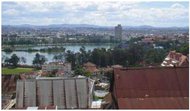Urbanization in Africa
 Market street in Essaouira, Morocco. (Source: J.C. Mohamed-Katerere)
Market street in Essaouira, Morocco. (Source: J.C. Mohamed-Katerere) African society is rapidly changing from rural to urban, with cities and towns expanding, not only in terms of population growth, but also spatially. They are taking up more space and encroaching on rural and agriculturally productive land. Globally, urban and built-up areas occupied in 1999 more than 471 million hectares (ha) – about 4 percent of the total land area. Abidjan, for example, covered in 1999 more than 57,735 ha of which 36,003 ha, or 62 percent of the area of the metropolis, was for natural spaces, 3,396 ha or 5.88 percent was classified as urban land, 1,778 ha or 4.9 percent of the city area was set aside for human activities and 2,825 ha for installations, excluding road networks.
 Downtown Antananarivo, Madagascar. (Source: V. Rabesahala)
Downtown Antananarivo, Madagascar. (Source: V. Rabesahala) One of the major impacts of urbanization in Africa is the increased generation of solid waste, which contributes to land conversion for landfills. For example, in the African Small Island Developing States (SIDS) of the Indian Ocean, at least 2.8 million tonnes of solid wastes are generated annually, of which only 30 percent are collected routinely. Beach deposited rubbish is estimated to be about 40,640 tonnes per year, threatening coastal ecosystems and undermining economic activities such as fisheries and tourism. The dumping of solid wastes in rivers, on beaches and in the sea has become common practice, particularly in the Comoros and Madagascar. However, such practices have been discontinued in Seychelles and Mauritius, both of which have adopted a national solid waste management plan. They have also invested in infrastructural development, with Seychelles spending between US$6-8 million in solid waste management over the last ten years.
Despite the negative attributes of urbanization, these new and growing areas, which are located in coastal areas and the hinterland, have also become vibrant centers of education, culture, commerce and industry and technological innovation, providing opportunities for various manufacturing and service industries.
Further reading
- Attahi, K., 1999. In Managing the Monster: Urban Waste and Governance in Africa (ed. Onibokun,A.G.), pp. 11-48. International Development Research Centre, Ottawa.
- Payet, R.A., et al,2004. Indian Ocean Islands – Global International Waters Assessment Regional Assessment 45b. United Nations Environment Programme, Nairobi.
- UNEP, 2006. Africa Environment Outlook 2
- WRI,UNDP, UNEP and World Bank, 2000. World Resources 2000-2001: People and Ecosystems - the Fraying Web of Life. World Resources Institute,Washington, D.C.
|
|
| Disclaimer: This article is taken wholly from, or contains information that was originally published by, the United Nations Environment Programme. Topic editors and authors for the Encyclopedia of Earth may have edited its content or added new information. The use of information from the United Nations Environment Programme should not be construed as support for or endorsement by that organization for any new information added by EoE personnel, or for any editing of the original content. |